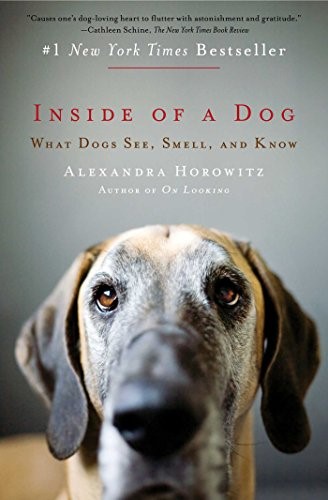Inside of a Dog: What Dogs See, Smell, and Know

from amazon.com
The bestselling book that asks what dogs know and how they think. The answers will surprise and delight you as Alexandra Horowitz, a cognitive scientist, explains how dogs perceive their daily worlds, each other, and that other quirky animal, the human.
Horowitz introduces the reader to dogs’ perceptual and cognitive abilities and then draws a picture of what it might be like to be a dog. What’s it like to be able to smell not just every bit of open food in the house but also to smell sadness in humans, or even the passage of time? How does a tiny dog manage to play successfully with a Great Dane? What is it like to hear the bodily vibrations of insects or the hum of a fluorescent light? Why must a person on a bicycle be chased? What’s it like to use your mouth as a hand? In short, what is it like for a dog to experience life from two feet off the ground, amidst the smells of the sidewalk, gazing at our ankles or knees?
Inside of a Dog explains these things and much more. The answers can be surprising—once we set aside our natural inclination to anthropomorphize dogs. Inside of a Dog also contains up-to-the-minute research—on dogs’ detection of disease, the secrets of their tails, and their skill at reading our attention—that Horowitz puts into useful context. Although not a formal training guide, Inside of a Dog has practical application for dog lovers interested in understanding why their dogs do what they do. With a light touch and the weight of science behind her, Alexandra Horowitz examines the animal we think we know best but may actually understand the least. This book is as close as you can get to knowing about dogs without being a dog yourself.
https://www.amazon.com/Inside-Dog-What-Dogs-Smell-ebook/dp/B002NT3B52
Author: Alexandra Horowitz

Reviewed by: John Stokdijk

Alexandra Horowitz, the author of Inside of a Dog: What Dogs See, Smell, and Know, loves dogs. She is a scientist who studies the behavior and cognition of dogs. She is also a dog owner and her book tells us about Pump, a mutt who had lived with her for all of his sixteen years at the time she wrote her book.
My first experience of a dog was as a young boy. That experience was very pleasant but the dog was not real. Lassie was a beautiful collie and the subject of a very popular television series of the same name in the 1960s and I liked watching that program.
My second experience started around age ten and was unpleasant. There had been a number of robberies in the rural community in which we lived. My father got a guard dog to protect his property. That dog was a German Shepherd which was aptly named Wolf. The dog was fierce and I never overcame my fear of it.
I was well into my twenties when I had my first positive experience with a dog named Captain. He lived on my wife’s family farm which we visited often. For some reason Captain seemed to like me. He loved to play and always seemed happy to see us. I would sometimes go for a run of about four miles and Captain would go with me every step of the way.
I am not a dog person and I have never had a dog of my own. Consequently, Inside of a Dog was not a book that captured my interest, but I read it anyway. As the leader of the Ajijic Book Club, it is my intention to read every book selected by members, at least for the foreseeable future.
And I learned something from this book. I had a general awareness that dogs have a much better sense of smell than humans. The degree of difference is amazing.
Human noses have about six million of these sensory receptor sites; sheepdog noses, over two hundred million; beagle noses, over three hundred million… The difference in the smell experience is exponential… it’s been estimated that their sense of smell may be millions of times more sensitive than ours… a dog can detect a teaspoon of sugar diluted in a million gallons of water: two Olympic-sized pools full.
In Chapter 10, at long last, my interest was heightened when Horowitz mentioned an article with which I am quite familiar.
Thirty-five years ago, the philosopher Thomas Nagel began a long-running conversation in science and philosophy about the subjective experience of animals when he asked, “What is it like to be a bat?”
I am interested in the subjective experience of other human beings, not that of dogs. However, the experience of human beings and dogs can be very interesting. The impact of dogs on humans can be profound.
At my last place of employment prior to retirement, my responsibilities included office management. One of our employees had a serious mental illness and suffered from severe bouts of anxiety. She had a service dog named Koyn for which I had to obtain special permission for it to be in the building. Koyn was loved by everyone and had a positive impact on the mental health of almost all employees, not just her owner. I would be quite interested in a book about the ongoing research into the impact of dogs on human beings with mental illnesses.
Finally I would like to share the story of Dennis Anderson and his dog Chimo. Dennis was President of the Canadian Mental Health Association in Alberta when I was on the Board of the Calgary Region of CMHA. Dennis credits Chimo with saving his life and what followed is quite a good story, worthy of a book. Chimo Animal Assisted Wellness and Learning Society.
